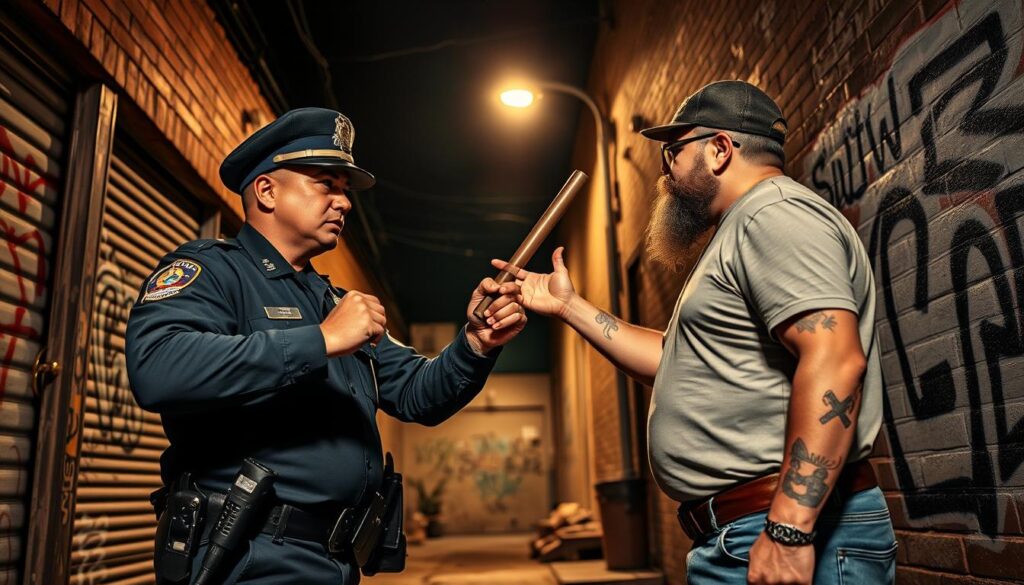
The Sovereign Citizen Movement has been getting more attention. It rejects government authority and focuses on individual freedom. This idea is both complex and wide-ranging.
Those who believe in this movement think they don’t have to follow government rules. They believe they can live their lives as they choose. This has caused problems with the police and worries about safety.
It’s important to understand the history, beliefs, and actions of the Sovereign Citizen Movement. This helps us see how it affects society.
Key Takeaways
- The Sovereign Citizen ideology rejects government authority.
- Believers think they are not bound by government laws.
- The movement has led to confrontations with law enforcement.
- Understanding the movement is key to addressing its implications.
- The ideology is complex and multifaceted.
What Is the Sovereign Citizen Movement?
The sovereign citizen movement is a group of people who don’t want government control. They believe everyone should live their life without government rules.
Definition and Core Concept
This movement is all about individual sovereignty. They think they’re not bound by government laws. Instead, they follow natural law and make their own life choices.
Sovereign Citizen Ideology
They distrust government a lot. They think governments go too far and take away their rights. So, they try to stand up for their freedom and challenge the government.
Estimated Size and Demographics
It’s thought that hundreds of thousands of people are part of this movement. Some say there could be as many as 500,000 in the U.S. People from all walks of life join, making it diverse. The movement is growing, attracting more people who like its ideas and actions.
Historical Origins and Development
In the 1970s and 1980s, people started to distrust the government more. This distrust led to the sovereign citizen movement. It was a time when many felt the government was not fair.
Early Foundations in the 1970s and 1980s
The sovereign citizen movement began by rejecting government control. People started to doubt the laws and rules of the government. This was the start of a big change.
Those early followers believed in natural law. They wanted to live without government rules. This idea attracted many to the movement.
Posse Comitatus and Tax Protest Movements
The Posse Comitatus movement started in the 1970s. It believed in living free from government. The tax protest movement also grew during this time. Together, they fueled the distrust of government.
Evolution and Growth in the Digital Age
The internet and social media changed everything in the late 20th and early 21st centuries. They helped the sovereign citizen movement grow. Now, people could easily find and share information.
This made the movement bigger and more complex. It included many conspiracy theories. The digital age helped the movement survive and grow, making it a challenge for everyone.
The Sovereign Citizen Movement Ideology
Sovereign citizens believe in being free from government control. They think that individuals should not be bound by laws made by others. Their beliefs include rejecting government power, following “natural law,” and believing in many conspiracy theories.
Rejection of Government Authority
At the heart of their beliefs is the idea that governments are too powerful. They think that governments go beyond what the Constitution allows. They believe that people should live without government interference.
“We are not subjects of the government, but the government is our servant.”
This view makes them question government rules, laws, and institutions.
Belief in “Natural Law” vs. Statutory Law
Sovereign citizens prefer “natural law” over laws made by governments. They see “natural law” as coming from nature and being more important. They believe in following “natural law” over government laws.
“The law of nature is the basis for all human conduct.”
Conspiracy Theories and Worldview
The movement is filled with conspiracy theories. These theories say governments are corrupt and control people secretly. For example, they think gold-fringed flags in courts mean maritime law, which they see as wrong.
In summary, the sovereign citizen movement is about rejecting government, following “natural law,” and believing in conspiracy theories. Knowing these parts helps us understand the movement and its effects on society.
Common Sovereign Citizen Beliefs
The Sovereign Citizen Movement has a complex set of beliefs. These beliefs question the government’s authority. They are diverse and shape the movement’s actions against government control.
The Strawman Theory
The Strawman Theory is central to the movement. It says the government holds people captive through fictional entities like corporations. Sovereign citizens believe understanding and rejecting the strawman frees them from government control.
They see two personas: the real person and the government’s “strawman.” By recognizing this, they claim to escape government jurisdiction.
Redemption Theory
The Redemption Theory is another key belief. It suggests individuals can escape government control through specific actions. Filing UCC financing statements is one tactic sovereign citizens use.
They believe these actions free them from government interference. The theory aims to help individuals reclaim their rights and freedom.
Maritime Law and Gold-Fringed Flags
Sovereign citizens think gold-fringed flags in courtrooms mean maritime law applies. They believe this law doesn’t apply to land-based citizens. This belief helps them challenge court jurisdiction and argue they’re not bound by certain laws.
Beliefs and Practices
Maritime law and gold-fringed flags are part of a larger set of beliefs. Sovereign citizens use these to challenge government authority. They file documents and make claims based on their legal interpretations.
Birth Certificate and Social Security Theories
Sovereign citizens see birth certificates and Social Security numbers as proof of government control. They believe these documents create a fictional entity or “strawman” for each person. To assert their independence, some try to “revoke” their birth certificates or reject their Social Security numbers.
Sovereign Citizen Tactics and Strategies

To grasp the sovereign citizen movement, we must look at their tactics and strategies. They use many ways to challenge government power and disrupt its work.
Paper Terrorism and Fraudulent Filings
Sovereign citizens often use “paper terrorism” by filing fake documents and lawsuits. They target government officials and institutions. They file false liens on property, submit fake court documents, and flood government offices with FOIA requests. These actions aim to waste the government’s time and money.
Unusual Court Behaviors and Language
In court, sovereign citizens act strangely and speak in odd ways. They might deny the court’s power, use old or made-up legal terms, and disrupt proceedings. Some claim to be “traveling” or “sojourning” to avoid legal duties. Their goal is to question the court’s authority and cause confusion.
Identification and Document Practices
Sovereign citizens make their own ID documents, like passports and driver’s licenses. They believe these IDs are more important than government-issued ones. They also use different names and aliases to hide their identities and avoid legal duties. This is part of their plan to reject government authority and live outside the law.
By knowing these tactics, law enforcement and government can better fight the sovereign citizen movement. They need to understand the movement’s methods and beliefs to respond effectively.
Legal Responses to Sovereign Citizen Claims
Legal systems have found ways to deal with the sovereign citizen movement. Courts have been key in fighting these claims. They have consistently ruled against the sovereign citizen’s arguments.
Court Rulings on Sovereign Arguments
Courts in the U.S. have always said no to sovereign citizen claims. They’ve made it clear that everyone must follow the law. This shows that the sovereign citizen’s beliefs don’t hold up in court.
One case is where a sovereign citizen argued they were not under the court’s jurisdiction. The court said no, pointing out that everyone in the area must follow the law.
| Case | Ruling | Implication |
|---|---|---|
| United States v. Sovereign Citizen Defendant | Court dismissed sovereign citizen claims, affirming jurisdiction. | Established that sovereign citizens are not exempt from legal jurisdiction. |
| State v. Sovereign Citizen | Court rejected argument that statutory law does not apply. | Confirmed the applicability of statutory law to all individuals. |
Legislative Actions Against Paper Terrorism
Governments have also acted to stop paper terrorism and other sovereign citizen tactics. They’ve made laws stricter on fake filings and increased penalties for these crimes.
Some states have made laws to fight false liens and paper terrorism. This gives police more ways to fight these issues.
Looking at these court decisions and laws, we understand the fight against the sovereign citizen movement better.
Law Enforcement Challenges and Responses

The sovereign citizen movement is a big challenge for law enforcement. They need special training to handle these situations well. Officers face many problems, from verbal fights to legal battles.
Officer Safety Concerns
Officers often meet sovereign citizens during traffic stops or when serving warrants. These situations can get out of hand fast. Officer safety is a top priority because these citizens might be armed and ready to fight.
In 2010, two police officers in West Memphis, Arkansas, were shot by a sovereign citizen. This shows how dangerous these encounters can be for officers.
Training and Protocols for Encounters
To keep officers safe, law enforcement has created specialized training programs. These teach officers how to spot sovereign citizens, calm down tense situations, and use the right legal and tactical steps.
Training covers how to spot sovereign citizen tactics, like filing fake liens or using special legal terms. Knowing these tactics helps officers get ready for and handle these encounters better.
| Training Component | Description | Benefit to Law Enforcement |
|---|---|---|
| Identification Techniques | Training on how to identify sovereign citizens during stops or encounters. | Enhanced officer safety through early recognition. |
| De-escalation Techniques | Methods to calm situations involving sovereign citizens. | Reduced risk of physical confrontations. |
| Legal Protocols | Guidelines on handling legal challenges posed by sovereign citizens. | Improved legal standing and reduced litigation. |
Notable Confrontations with Law Enforcement
There have been many famous fights between law enforcement and sovereign citizens. These have led to violence and sometimes death.
“The FBI considers sovereign citizens a domestic terrorism threat due to their propensity for violence against law enforcement and government officials.”
These cases show why law enforcement must stay alert and use effective strategies against the sovereign citizen movement.
Debunking Sovereign Citizen Legal Theories
Looking closely at sovereign citizen legal theories shows big mistakes in understanding the law. They often argue against government power based on wrong ideas about the law.
Constitutional Misinterpretations
Sovereign citizens get the Constitution wrong, mainly about personal rights and government roles. They might say the Constitution stops certain government actions. But they miss the point and ignore the law’s history and purpose.
Legal Precedents Rejecting Sovereign Claims
Courts have always turned down sovereign citizen claims. They’ve set clear rules. These show that sovereign citizens’ views don’t hold up and we must follow government laws.
“The sovereign citizen movement’s legal arguments are not supported by the law or the Constitution.” –
Expert Analysis and Critiques
Law and history experts have pointed out the sovereign citizen movement’s mistakes. They show how important it is to know the law as it is, not as sovereign citizens imagine.
| Aspect | Sovereign Citizen Claim | Legal Reality |
|---|---|---|
| Constitutional Interpretation | Misinterpret provisions to challenge government authority | Courts have consistently upheld constitutional provisions |
| Legal Precedents | Ignore or misinterpret legal precedents | Courts rely on established precedents to reject sovereign claims |
Conclusion
The sovereign citizen movement is complex and poses big challenges for law enforcement and society. By looking into the sovereign citizen history and beliefs, we can understand its impact. We also see the efforts to fight it.
We can tackle the movement’s risks with education, training, and laws. This helps make our society safer and fairer for everyone. It’s important to know the sovereign citizen beliefs and sovereign citizen tactics to fight them well.
Knowing what a sovereign citizen is and their ideology helps law enforcement and the public. Fighting sovereign citizens debunked legal ideas and educating people about the dangers is key.





